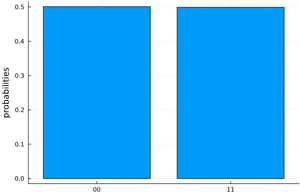Snowflurry
Snowflurry
Developed in Julia by Anyon Systems, Snowflurry is an open-source quantum computing library to build, simulate and run quantum circuits. A related library called SnowflurryPlots shows simulation results in a bar graph. Useful to explore quantum computing, its features are described in the documentation and the installation guide is available on the GitHub page. Like the PennyLane library, Snowflurry can be used to run quantum circuits on the MonarQ quantum computer.
Installation
Le simulateur d'ordinateur quantique avec Snowflurry est accessible sur toutes nos grappes. Avant d'avoir accès à Snowflurry, il faur charger le langage de programmation Julia avec la commande
[name@server ~]$ module load julia
The Julia programming interface is then called and the Snowflurry quantum library is loaded (about 5-10 minutes) with the commands
[name@server ~]$ julia
julia> import Pkg
julia> Pkg.add(url="https://github.com/SnowflurrySDK/Snowflurry.jl", rev="main")
julia> Pkg.add(url="https://github.com/SnowflurrySDK/SnowflurryPlots.jl", rev="main")
julia> using Snowflurry
Quantum logic gates and commands are described in the Snowflurry documentation.
Use case: Bell states
Bell states are maximally entangled two-qubit states. They are simple examples of two quantum phenomena: superposition and entanglement. The library Snowflurry allows to construct the first Bell state as follows.
[name@server ~]$ julia
julia> using Snowflurry
julia> circuit=QuantumCircuit(qubit_count=2);
julia> push!(circuit,hadamard(1));
julia> push!(circuit,control_x(1,2));
julia> print(circuit)
<div lang="fr" dir="ltr" class="mw-content-ltr">
Quantum Circuit Object:
qubit_count: 2
q[1]:──H────*──
¦
q[2]:───────X──
Dans la section de code ci-dessus, la porte de Hadamard crée une superposition égale de |0⟩ et |1⟩ sur le premier qubit tandis que la porte CNOT (porte X controllée) crée une intrication entre les deux qubits. On retrouve une superposition égale des états |00⟩ et |11⟩, soit le premier état de Bell. La fonction simulate permet de simuler l'état exact du système.
julia> state = simulate(circuit)
julia> print(state)
4-element Ket{ComplexF64}:
0.7071067811865475 + 0.0im
0.0 + 0.0im
0.0 + 0.0im
0.7071067811865475 + 0.0im
Pour effectuer une mesure, l'opération readout permet de spécifier quels qubits seront mesurés. La bibliothèque SnowflurryPlots et la fonction plot_histogram permettent de visualiser les résultats.
[name@server ~]$ julia
julia> using SnowflurryPlots
julia> push!(circuit, readout(1,1), readout(2,2))
julia> plot_histogram(circuit,1000)
